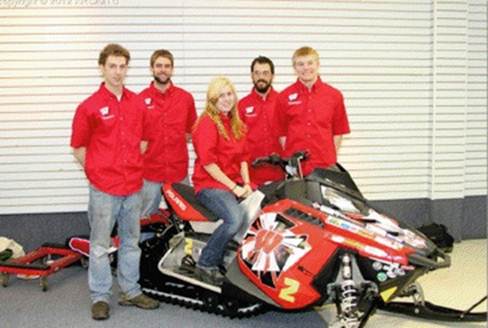
Clean Snowmobile Challenge™
The SAE International Clean Snowmobile Challenge (CSC) is an engineering design competition for college and university student members that challenge engineering students to reengineer an existing snowmobile to reduce emissions and noise. Their modified snowmobiles will compete in a variety of events including emissions, noise, fuel economy/endurance, acceleration, handling, static display, cold start and design.
The CSC Rules Committee makes changes to the competition each year to keep the competition fresh and to present new engineering challenges. CSC is primarily an "engine" competition however the underlying theme has remained consistent to engineer a clean and quiet trail sled. Current trail sleds are engineered to these standards, but it is possible to achieve more. Noise levels can be reduced and cleaner fuels can lead to lower emissions.
Competition Objective for IC Engines
The intent of the competition is to develop a snowmobile that is acceptable for use in environmentally sensitive areas such as our National Parks or other pristine areas. The modified snowmobiles are expected to be quiet, and emit significantly less unburned hydrocarbons and carbon monoxide than current production snowmobiles, without significantly increasing oxides of nitrogen emissions. The modified snowmobiles are also expected to be cost-effective
and comfortable for the operator to drive. The intent of the competition is to design a touring snowmobile that will primarily be ridden on groomed snowmobile trails. The use of unreliable, expensive solutions is strongly discouraged! Modern snowmobiles are engineered to meet the current standards for noise and emissions. Teams are expected to add innovative solutions for improving on the performance of the base sled that they start with. Design judges (written and oral) will be looking for innovations and incorporating that into their scores.
The minimum performance expectations for a trail IC snowmobile are set by these rules as a sled that by design will go 100 miles without refueling and can attain a trail speed of 45 miles per hour on a smooth trail. Additionally they should be able to traverse 500 feet in 12 seconds or less. Designs that do not have a reasonable expectation of achieving these requirements will be allowed to compete only on an "Exhibition" basis
Competition Objective for Zero Emissions Category
The Greenland Ice Cap acts like a sponge, absorbing atmospheric chemicals produced naturally, or via anthropogenic activities. Many of these chemicals are also photoactive in the lower troposphere and even in the upper layers of the snow. Research underway at Summit Station seeks to understand the processes involved, and how it might play into the global cycling of these agents. Some of the chemical constituents under study are measured in parts per billion. Emissions resulting from the burning of fossil fuels on site can hopelessly skew the research results. Due to the sensitive nature of much of the research being conducted at Summit Station, NSF seeks to find a "zero-emissions" vehicle for transporting researchers and support staff to and from research sites.
Electric snowmobiles or other forms of zero-emissions transportation have long been sought. Range and performance have always been extremely limiting factors that have precluded the successful development of commercially available models. Recent advancements in battery and motor technology have finally made it possible to realize vehicles with ranges adequate for some purposes. Zero-emissions personal transportation would allow the operation of more distant satellite camp facilities, and allow access to areas previously accessible only by foot. In short, this is a tool that the research community needs now. Snowmobiles in this category must be zero-emissions by default. Therefore, no test or points will be given for emissions. Instead, range and draw bar performance will be measured. Innovation will also be judged in this category.
SAE Links :
|

